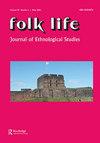Basketry & Beyond: Constructing Cultures
IF 0.1
4区 社会学
0 FOLKLORE
引用次数: 0
Abstract
disappearing, the creation of the Tullie House museum (opened 1893) provided the trigger, making this a period collection in its own right today. The Milbourne collection from Cumbrian farms was added in 1946–51. This delightful little volume in A5 format is very easy to use. References in the main text link to a summary Bibliography and Notes, conveniently on facing pages. The volume concludes with a catalogue, clearly listing accession number (useful for access enquiries), object name, dimensions and provenance detail (so often lost or overlooked). The catalogue object numbering links directly to the illustrations that are grouped around processes such as drainage, harvesting, etc. or the specific equipment associated with shepherding, milking, butter and cheese-making. To conclude, there is a fearsome set of different types of animal traps. The author’s grouped illustrations are his distinctive trademark. My personal preference is for the distinctive black-and-white treatment so successfully used in earlier volumes, such as the Torquay study; but colour adds a new dimension, particularly in the recreation scenes, both perhaps best appreciated in a larger format than this volume offers. Finally, to state the obvious that this project, as with so many others in Peter Brears’ repertoire was a labour of love, achieved largely if not completely at this own expense, ‘several weeks’ having been spent in the museum stores ‘while studying and drawing the collection’. How rare is that these days? The Society’s 2019 annual conference held at Tullie House included a memorable and much appreciated presentation on this project by the author along with museum staff, reported in Folk Life Newsletter, no. 35 for Spring 2020.编织及超越:构建文化
图利故居博物馆(1893年开放)的创建为其消失提供了导火索,使其成为今天的时代藏品。来自坎布里亚农场的米尔伯恩收藏于1946–51年。这个令人愉快的A5格式的小音量非常容易使用。正文中的参考文献链接到摘要书目和注释,方便地在对开页上。该卷最后有一个目录,清楚地列出了登录号(有助于查询)、物体名称、尺寸和出处详细信息(经常丢失或被忽视)。目录对象编号直接链接到围绕排水、收割等过程分组的插图,或与牧羊、挤奶、黄油和奶酪制作相关的特定设备。总之,有一套可怕的不同类型的动物陷阱。作者的成组插图是他与众不同的标志。我个人更喜欢早期的研究中成功使用的独特的黑白处理,比如托基研究;但色彩增加了一个新的维度,尤其是在娱乐场景中,两者都可能以比这本书更大的格式来欣赏。最后,要说明的是,这个项目和彼得·布雷斯作品中的许多其他项目一样,是一项爱的劳动,即使不是完全由自己承担,也在很大程度上是由自己完成的,“几个星期”都是在博物馆商店里“研究和绘制藏品”。现在这种情况有多罕见?据《民间生活通讯》2020年春季第35期报道,该协会在Tullie House举行的2019年年年会上,作者和博物馆工作人员就这个项目做了一次令人难忘且备受赞赏的演讲。
本文章由计算机程序翻译,如有差异,请以英文原文为准。
求助全文
约1分钟内获得全文
求助全文
来源期刊
CiteScore
0.30
自引率
66.70%
发文量
17
期刊介绍:
Folk Life: Journal of Ethnological Studies is a journal devoted to the study of all aspects of traditional ways of life in Great Britain and Ireland. The journal publishes original, high quality, peer-reviewed research in the form of unsolicited articles, solicited papers (which are usually selected from those read at the Society"s annual conference) and of members" papers (which are usually short reports of work in progress). Work published in Folk Life may include, for example, papers dealing with the traditional ways of life of other countries and regions, which may be compared to or contrasted with those of Great Britain and Ireland.

 求助内容:
求助内容: 应助结果提醒方式:
应助结果提醒方式:


